Sustainable Transitions Narratives: An Analysis of the Literature through Topic Modelling
Abstract
:1. Introduction
‘Transitions are not teleological and deterministic, but continuously enacted by and contested between a variety of actors. … So, transitions are likely to be non -linear; two steps forward may be followed by one step back (or steps in a different direction if actors change their beliefs and goals or if there is growing contestation of particular pathways).’[11] (p. 900)
2. Material and Methods
2.1. Topic Modelling
2.2. Data Description
2.3. Model Choice
3. Results
3.1. The Social Change and Capitalism Cluster
“Theorizations of sustainability transformation have foregrounded the construction (making) of novel socioecological relations; however, they generally have obscured processes of deliberate deconstruction (unmaking) of existing, unsustainable ones. Amidst ever more compelling evidence of the simultaneous unsustainability and continued reproduction of capitalist modernity, it is misguided to assume that transformation can happen by the mere construction of supposed solutions, be they technological, social or cultural. We rather need to better understand whether and how existing institutions, forms of knowledge, practices, imaginaries, power structures, and human-non-human relations can be deconstructed at the service of sustainability transformation. This paper demonstrates the usefulness of a lens that attends to processes of making and unmaking in sustainability transformations through an analysis of an ongoing sustainability transformation, the territorios campesinos agroalimentarios (TCA) endogenous territorial figure and peasant movement in Colombia. TCA is transforming territory beyond capitalism on the basis of relational ontologies and principles of autonomy, dignity and sufficiency. This paper identifies processes of unmaking of capitalism in the TCA and demonstrates how they are concretely entangled in the construction of post-capitalist realities. This paper sketches a research agenda on sustainability transformation that is sensitive to and theoretically equipped for the analysis of transformation as a multifaceted, multilevel process that entails the deconstruction of capitalist modernity and the construction of post-capitalist realities. Central to this agenda is a plural engagement with theories of social change from across the social sciences and humanities, which have not previously been mobilized for this endeavour.”[28] (p. 1)
“Community energy initiatives can foster a sustainable energy transition by promoting sustainable energy behaviour in the communities in which they are embedded. This raises the question of what motivates people to become involved in these initiatives. We investigated the importance of financial, environmental, and communal motives for initiative involvement. We propose that communal motives (i.e., being involved in one’s local community) may be related to initiative involvement, as community energy initiatives not only aim to promote sustainable energy behaviour but also enable people to be involved in their community. Across three studies, respondents rated financial and environmental motives as more important than communal motives for their involvement in community energy initiatives. Yet, environmental and communal motives were uniquely related to initiative involvement, while financial motives were not. The discrepancy between which motives people rate as important and which motives actually relate to their initiative involvement suggests that financial motives are an overrated motive, while communal motives are an underrated motive for involvement in community energy initiatives. Our results suggest that targeting communal motives may be an additional way to enhance involvement in community energy initiatives and foster sustainable behaviour among people, who may not otherwise be interested in environmental protection.”[34] (p. 1)
“The paper discusses the role of visions within sustainability assessment and governance for sustainable development in Europe. Currently, our societies (still) develop along an unsustainable path, which results in a number of persistent problems (climate change, loss of biodiversity, poverty, etc.). Integrated sustainability assessment (ISA) is one approach designed to initiate transitions towards sustainability. Visions of a sustainable future form an important part of ISA. These visions support the process of discussing how the transition from today’s societies/systems to a sustainable future can be achieved. According to the principles of ISA, visions should be developed in a participatory way, thus including the ideas and perceptions of stakeholders, decision-makers, experts and/or citizens. The paper starts with an introduction of the concepts of visions and scenarios and describes exemplary methods for their participatory development. Then, the main concepts for integrated sustainability assessment in comparison with other impact assessments are discussed. The main body of the paper presents experiences in three projects (ARTEMIS, ALARM, ECOCHANGE) in which visions and scenarios of sustainable futures were developed with stakeholders. The paper concludes with lessons learned and suggestions for future applications for participatory scenario development.”[37] (p. 271)
3.2. The Energy Cluster
“This article proposes the extension of a conceptual framework aimed at analysing policy mixes and their out-comes and demonstrates its value added for the study of sustainability transitions. The argument is that policy mixes research should not focus only on the form of policy instruments, but also on their implementation context. Policy mix form designates the specific policy instruments that are involved according to a policy strategy. Policy mix context includes the specific setting where each policy measure is implemented, such as enterprise or family. It also includes the specific target group of each measure, such as youth or smokers. We apply this conceptual framework to the policy concept and implementation of tobacco control policies in Switzerland, which are an exemplary case for analysing transitions as they are geared towards behavioural change. In a mixed method approach, we triangulate different sets of quantitative and qualitative indicators in order to assess the implementation of eleven subnational policy mixes. Our findings show that taking into account the moderating role of settings between policy instruments and target groups allows for a more in-depth analysis of policy processes. Observing the interactions between the four elements policy instruments, policy strategy, the implementation settings and the target groups allows capturing the complexity of policy mixes, at the crossroads of policy design, policy implementation and policy outcomes. Taking implementation settings and target groups into account in the analysis of policy mixes allows for a refined understanding of policy compliance and thus, from a broader perspective, of sustainability transitions.”[42] (p. 1)
“Carbon capture and storage (CCS) is increasingly depicted as an important element of the carbon dioxide mitigation portfolio. However, critics have warned that CCS might lead to reinforced fossil fuel lock-in, by perpetuating a fossil fuel based energy provision system. Due to large-scale investments in CCS infrastructure, the fossil fuel based ‘regime’ would be perpetuated to at least the end of this century. In this paper we investigate if and how CCS could help to avoid reinforcing fossil fuel lock-in. First we develop a set of criteria to estimate the degree of technological lock-in. We apply these criteria to assess the lock-in reinforcement effect of adding CCS to the fossil fuel socio-technical regime (FFR). In principle, carbon dioxide could be captured from any carbon dioxide point source. In the practice of present technological innovations, business strategies, and policy developments, CCS is most often coupled to coal power plants. However, there are many point sources of carbon dioxide that are not directly related to coal or even fossil fuels. For instance, many forms of bio-energy or biomass-based processes generate significant streams of carbon dioxide emissions. Capturing this carbon dioxide which was originally sequestered in biomass could lead to negative carbon dioxide emissions. We use the functional approach of technical innovations systems (TIS) to estimate in more detail the strengths of the niches CCS and Bio-Energy with CCS (BECCS). We also assess the orientation of the CCS niche towards the FFR and the risk of crowding out BECCS. Next we develop pathways for developing fossil energy carbon capture and storage, BECCS, and combinations of them, using transition pathways concepts. The outcome is that a large-scale BECCS development could be feasible under certain conditions, thus largely avoiding the risk of reinforced fossil fuel lock-in.”[49] (p. 282)
“Despite discussion of a ‘carbon lock-in’ and techno-institutional barriers to change, energy studies have had little serious contact with neo-Schumpeterian theorizing on technological ‘surges’ of creative destruction, which have characterized the entire industrial era from the 1770s on. In this paper a way is offered to link the current surge in renewable energy investment to the theorizing over long (Kondratiev) waves and techno-economic paradigm shifts. The paper argues that the current renewable energy surge can be best comprehended as a secondary surge in the fifth long K-wave, coinciding with the shift from gestation to installation of a new sixth techno-economic paradigm within the matrix of the fifth. It is argued that this emergent 6th paradigm is a continuation and fulfilment of the 5th, where IT and ICT are applied to the electric power grid, and that both are in conflict with the still-incumbent 4th paradigm based on fossil fuels and centralized power generation. The emergent 6th paradigm is driven by the technology surge associated with renewable energies, particularly in China where the investment is most intense and the falling costs are driving market expansion. It portends a renewable energy speculative financial boom and bubble which could burst sometime in the period 2015–2020, ushering in a period of sustained development of renewables and energy-efficiency services by productive rather than financial capital.”[50] (p. 10)
3.3. The Innovation Cluster
“The implementation of innovative sustainability technologies often requires far-reaching changes of the macro environment in which the innovating firms operate. Strategic management literature demonstrates that the chances of a successful diffusion and adoption of an innovative technology in society are increased if the firms wanting to commercialize this technology collaborate in networks or industry clusters to build a favourable environment for their technology. However, the strategic management literature does not offer advice on how to strategically create this supportive external environment. We fill this gap with complementary insights from the technological innovation systems literature. We introduce the concept of strategic collective system building; this concept describes processes and activities that networks of actors can strategically engage in to collectively build a favourable environment for their innovative sustainability technology. Furthermore, we develop a strategy framework for collective system building. To underpin our theoretical analysis empirically, we have conducted a case study in the Dutch smart grid field. The resulting strategy framework consists of four key areas: technology development and optimization, market creation, socio-cultural changes and coordination. Each of these key strategic areas is composed of a set of system-building activities.”[4] (p. 2328)
“The growing urgency of environmental threats combined with the slow pace of sustainability transitions has turned attention towards a better understanding of regime destabilization. Focusing excessively on niche innovations could be incumbent regimes' diversion and resistance strategy and could reinforce the “business as usual” mindset instead of contributing to system-wide changes. Historical cases of system transition have most often been used to understand the dynamics of regime destabilization. However, these insights have limitations when the focus is on ongoing transitions. Moreover, it is argued that more attention should be paid to agency and actors. Herein, regime destabilization is understood through an internally structured selection environment, implying that agency is assumed not only in variation at the niche level but also in the selection processes: (1) the selection environment is shaped by active and strategic actors and actor networks; (2) the selection environment is shaped by diverse discursive framings; and (3) the selection environment is shaped by various actors beyond the regime and even beyond the system in question. The argument is empirically tested in the case of the Finnish food system by constructing prevailing storylines in the sustainability transition. Four contrasting but partially overlapping storylines and their associated actor networks are identified. The empirical case supports the view that actors across all levels aim to influence the selection environment’s formulation with their framing of the problem and the strategic response. Thus, more attention must be paid to the content and diversity of different discursive framings in sustainability transitions.”[66] (p. 1513)
“The growing criticism of intensive agricultural practices that lead to a deterioration of natural resources and a decrease of biodiversity has progressively led to more environmental constraints being put on agricultural activities through an ecologization of agricultural policies. The aims of these policies have been to protect environmentally sensitive areas, to improve groundwater quality and, more recently, to develop organic farming and/or reduce pesticide use. However, these efforts are still a far cry from a robust ecologization of agricultural practices. In order to identify the conditions for the implementation of such an ecologization, the changes in practices from conventional agriculture towards organic farming and integrated pest management (IPM) are investigated using a sociological study of farmers’ trajectories, coupled with the ESR (Efficiency-Substitution-Redesign) framework developed by biological and agricultural scientists. This combined approach reveals that a robust ecologization of agricultural practices requires us to take into account the specific and variable tempo of farmers’ trajectories and to redesign not only technical agricultural systems but also interactions within larger agrifood systems.”[78] (p. 209)
3.4. Trends in Topics
3.5. Topics’ Prevalence in Sources
4. Conclusions
Author Contributions
Funding
Institutional Review Board Statement
Informed Consent Statement
Data Availability Statement
Conflicts of Interest
Appendix A
| No | Title | Authors, Year, and Journal | Citations | Markard et al., 2012 |
|---|---|---|---|---|
| 1 | Technological transitions as evolutionary reconfiguration processes: A multi-level perspective and a case-study | Geels F.W., 2002, Research Policy | 2787 | Yes |
| 2 | Typology of sociotechnical transition pathways | Geels F.W., Schot J., 2007, Research Policy | 2174 | Yes |
| 3 | From sectoral systems of innovation to socio-technical systems: Insights about dynamics and change from sociology and institutional theory | Geels F.W., 2004, Research Policy | 1743 | Yes |
| 4 | Regime shifts to sustainability through processes of niche formation: The approach of strategic niche management | Kemp R., Schot J., Hoogma R., 1998, Technology Analysis and Strategic Management | 1499 | Yes |
| 5 | Understanding carbon lock-in | Unruh G.C., 2000, Energy Policy | 1404 | Yes |
| 6 | Functions of innovation systems: A new approach for analyzing technological change | Hekkert M.P., Suurs R.A.A., Negro S.O., Kuhlmann S., Smits R.E.H.M., 2007, Technological Forecasting and Social Change | 1218 | |
| 7 | The governance of sustainable socio-technical transitions | Smith A., Stirling A., Berkhout F., 2005, Research Policy | 1143 | Yes |
| 8 | More evolution than revolution: Transition management in public policy | Rotmans J., Kemp R., Van Asselt M., 2001, Foresight | 1122 | Yes |
| 9 | The multi-level perspective on sustainability transitions: Responses to seven criticisms | Geels F.W., 2011, Environmental Innovation and Societal Transitions | 1089 | |
| 10 | Analyzing the functional dynamics of technological innovation systems: A scheme of analysis | Bergek A., Jacobsson S., Carlsson B., Lindmark S., Rickne A., 2008, Research Policy | 982 | Yes |
| 11 | On the nature, function and composition of technological systems | Carlsson B., Stankiewicz R., 1991, Journal of Evolutionary Economics | 982 | Yes |
| 12 | Strategic niche management and sustainable innovation journeys: Theory, findings, research agenda, and policy | Schot J., Geels F.W., 2008, Technology Analysis and Strategic Management | 926 | |
| 13 | Innovation studies and sustainability transitions: The allure of the multi-level perspective and its challenges | Smith A., Voß J.-P., Grin J., 2010, Research Policy | 846 | |
| 14 | Ontologies, socio-technical transitions (to sustainability), and the multi-level perspective | Geels F.W., 2010, Research Policy | 778 | |
| 15 | Transition management for sustainable development: A prescriptive, complexity-based governance framework | Loorbach D., 2010, Governance | 743 | |
| 16 | Regime Resistance against Low-Carbon Transitions: Introducing Politics and Power into the Multi-Level Perspective | Geels F.W., 2014, Theory, Culture & Society | 648 | |
| 17 | CAUTION! Transitions ahead: Politics, practice, and sustainable transition management | Shove E., Walker G., 2007, Environment and Planning A | 624 | Yes |
| 18 | Technological innovation systems and the multi-level perspective: Towards an integrated framework | Markard J., Truffer B., 2008, Research Policy | 622 | Yes |
| 19 | Toward a spatial perspective on sustainability transitions | Coenen L., Benneworth P., Truffer B., 2012, Research Policy | 566 | |
| 20 | What about the politics? Sustainable development, transition management, and long-term energy transitions | Meadowcroft J., 2009, Policy Sciences | 521 | |
| 21 | Why are institutions the ‘carriers of history’?: Path dependence and the evolution of conventions, organizations and institutions | David P.A., 1994, Structural Change and Economic Dynamics | 499 | |
| 22 | Growing grassroots innovations: Exploring the role of community-based initiatives in governing sustainable energy transitions | Seyfang G., Haxeltine A., 2012, Environment and Planning C: Government and Policy | 466 | |
| 23 | Transforming the energy sector: The evolution of technological systems in renewable energy technology | Jacobsson S., Bergek A., 2004, Industrial and Corporate Change | 445 | Yes |
| 24 | Can cities shape socio-technical transitions and how would we know if they were? | Hodson M., Marvin S., 2010, Research Policy | 438 | |
| 25 | A socio-technical analysis of low-carbon transitions: introducing the multi-level perspective into transport studies | Geels F.W., 2012, Journal of Transport Geography | 431 | |
| 26 | Processes and patterns in transitions and system innovations: Refining the co-evolutionary multi-level perspective | Geels F.W., 2005, Technological Forecasting and Social Change | 428 | Yes |
| 27 | The dynamics of transitions in socio-technical systems: A multi-level analysis of the transition pathway from horse-drawn carriages to automobiles (1860–1930) | Geels Ir.F.W., 2005, Technology Analysis and Strategic Management | 422 | |
| 28 | Transition management as a model for managing processes of co-evolution towards sustainable development | Kemp R., Loorbach D., Rotmans J., 2007, International Journal of Sustainable Development and World Ecology | 420 |
References
- Markard, J.; Raven, R.; Truffer, B. Sustainability transitions: An emerging field of research and its prospects. Res. Policy 2012, 41, 955–967. [Google Scholar] [CrossRef]
- European Environment Agency. SOER 2015—The European Environment—State and Outlook 2015, SOER 2015. Available online: https://www.eea.europa.eu/soer/2015 (accessed on 13 January 2022).
- Bui, S.; Cardona, A.; Lamine, C.; Cerf, M. Sustainability transitions: Insights on processes of niche-regime interaction and regime reconfiguration in agri-food systems. J. Rural. Stud. 2016, 48, 92–103. [Google Scholar] [CrossRef] [Green Version]
- Planko, J.; Cramer, J.M.; Chappin, M.M.; Hekkert, M.P. Strategic collective system building to commercialize sustainability innovations. J. Clean. Prod. 2016, 112, 2328–2341. [Google Scholar] [CrossRef] [Green Version]
- European Environmental Agency. Perspectives on Transitions to Sustainability; Publications Office of the European Union: Luxemburg, 2018; Available online: https://www.eea.europa.eu/publications/perspectives-on-transitions-to-sustainability (accessed on 13 January 2022).
- Geels, F.W. Technological transitions as evolutionary reconfiguration processes: A multi-level perspective and a case-study. Res. Policy 2002, 31, 1257–1274. [Google Scholar] [CrossRef] [Green Version]
- Kemp, R.; Schot, J.; Hoogma, R. Regime shifts to sustainability through processes of niche formation: The approach of strategic niche management. Technol. Anal. Strateg. Manag. 1998, 10, 175–198. [Google Scholar] [CrossRef]
- Hekkert, M.P.; Suurs, R.A.A.; Negro, S.O.; Kuhlmann, S.; Smits, R.E.H.M. Functions of innovation systems: A new approach for analysing technological change. Technol. Forecast. Soc. Chang. 2007, 74, 413–432. [Google Scholar] [CrossRef] [Green Version]
- Rip, A.; Kemp, R. Technological change. In Human Choice and Climate Change; Rayner, S., Malone, E.L., Eds.; Battelle Press: Columbus, OH, USA, 1998; pp. 327–399. [Google Scholar]
- Van Driel, H.; Schot, J. Radical Innovation as a Multilevel Process: Introducing Floating Grain Elevators in the Port of Rotterdam. Technol. Cult. 2005, 46, 51–76. [Google Scholar] [CrossRef] [Green Version]
- Geels, F.W.; Kern, F.; Fuchs, G.; Hinderer, N.; Kungl, G.; Mylan, J.; Neukirch, M.; Wassermann, S. The enactment of socio-technical transition pathways: A reformulated typology and a comparative multi-level analysis of the German and UK low-carbon electricity transitions (1990–2014). Res. Policy 2016, 45, 896–913. [Google Scholar] [CrossRef]
- Geels, F.W.; Verhees, B. Cultural legitimacy and framing struggles in innovation journeys: A cultural-performative perspective and a case study of Dutch nuclear energy (1945–1986). Technol. Forecast. Soc. Chang. 2011, 78, 910–930. [Google Scholar] [CrossRef]
- Bohr, J.; Dunlap, R.E. Key Topics in environmental sociology, 1990–2014: Results from a computational text analysis. Environ. Sociol. 2018, 4, 181–195. [Google Scholar] [CrossRef]
- Athey, S.; Imbens, G.W. Machine learning methods that economists should know about. Annu. Rev. Econ. 2019, 11, 685–725. [Google Scholar] [CrossRef]
- Gentzkow, M.; Kelly, B.; Taddy, M. Text as data. J. Econ. Lit. 2019, 57, 535–574. [Google Scholar] [CrossRef]
- Blei, D.M.; Lafferty, J.D. A correlated topic model of science. Ann. Appl. Stat. 2007, 1, 17–35. [Google Scholar] [CrossRef] [Green Version]
- Roberts, M.E.; Stewart, B.M.; Tingley, D. Stm: An R package for structural topic models. J. Stat. Softw. 2019, 91, 1–40. [Google Scholar] [CrossRef] [Green Version]
- Lindstedt, N.C. Structural Topic Modeling for Social Scientists: A Brief Case Study with Social Movement Studies Literature, 2005–2017. Soc. Curr. 2019, 6, 307–318. [Google Scholar] [CrossRef]
- Csardi, G.; Nepusz, T. The igraph software package for complex network research. Int. J. Complex Syst. 2006, 1695, 1–9. [Google Scholar]
- Bischof, J.; Airoldi, E.M. Summarizing topical content with word frequency and exclusivity. In Proceedings of the 29th International Conference on Machine Learning (ICML-12), Edinburgh, UK, 26 June–1 July 2012; pp. 201–208. [Google Scholar]
- Avelino, F. Theories of power and social change. Power contestations and their implications for research on social change and innovation. J. Political Power 2021, 14, 425–448. [Google Scholar] [CrossRef]
- Görg, C.; Brand, U.; Haberl, H.; Hummel, D.; Jahn, T.; Liehr, S. Challenges for Social-Ecological Transformations: Contributions from Social and Political Ecology. Sustainability 2017, 9, 1045. [Google Scholar] [CrossRef] [Green Version]
- Grenni, S.; Soini, K.; Horlings, L.G. The inner dimension of sustainability transformation: How sense of place and values can support sustainable place-shaping. Sustain. Sci. 2020, 15, 411–422. [Google Scholar] [CrossRef] [Green Version]
- Woiwode, C.; Schäpke, N.; Bina, O.; Veciana, S.; Kunze, I.; Parodi, O.; Schweizer-Ries, P.; Wamsler, C. Inner transformation to sustainability as a deep leverage point: Fostering new avenues for change through dialogue and reflection. Sustain. Sci. 2021, 16, 841–858. [Google Scholar] [CrossRef]
- Yunus, M.; Biggeri, M.; Testi, E. Social Economy and Social Business Supporting Policies for Sustainable Human Development in a Post-COVID-19 World. Sustainability 2021, 13, 12155. [Google Scholar] [CrossRef]
- Sen, A.K. Development as Freedom; Oxford University Press: New Delhi, India, 1999. [Google Scholar]
- Schwab, K.; Vanham, P. Stakeholder Capitalism: A Global Economy That Works for Progress, People and Planet; John Wiley & Sons Inc: Hoboken, NJ, USA, 2021. [Google Scholar]
- Feola, G.; Koretskaya, O.; Moore, D. (Un) making in sustainability transformation beyond capitalism. Glob. Environ. Chang. 2021, 69, 102290. [Google Scholar] [CrossRef]
- Goetz, A.; Gotchev, B.; Richter, I.; Nicolaus, K. Introduction to the special issue: Reform or revolution? What is at stake in democratic sustainability transformations. Sustain. Sci. Pract. Policy 2020, 16, 335–352. [Google Scholar] [CrossRef]
- Clark, D.A.; Biggeri, M.; Frediani, A.A. Participation, empowerment and capabilities: Key lessons and future challenges. In The Capability Approach, Empowerment and Participation; Clark, D.A., Biggeri, M., Frediani, A.A., Eds.; Palgrave Macmillan: London, UK, 2019; pp. 385–402. [Google Scholar]
- Mori, T.; Tasaki, T. Factors influencing pro-environmental collaborative collective behaviors toward sustainability transition—A case of renewable energy. Environ. Educ. Res. 2019, 25, 566–584. [Google Scholar] [CrossRef]
- Ferguson, R.; Lovell, S. Grassroots engagement with transition to sustainability: Diversity and modes of participation in the international permaculture movement. Ecol. Soc. 2015, 20, 39. [Google Scholar] [CrossRef] [Green Version]
- Dinnie, E.; Holstead, K.L. The influence of public funding on community-based sustainability projects in Scotland. Environ. Innov. Soc. Transit. 2018, 29, 25–33. [Google Scholar] [CrossRef]
- Sloot, D.; Jans, L.; Steg, L. In it for the money, the environment, or the community? Motives for being involved in community energy initiatives. Glob. Environ. Chang. 2019, 57, 101936. [Google Scholar] [CrossRef]
- Creamer, E.; Allen, S.; Haggett, C. ‘Incomers’ leading ‘community-led’ sustainability initiatives: A contradiction in terms? Environ. Plan. C Politics Space 2019, 37, 946–964. [Google Scholar] [CrossRef] [Green Version]
- Tourais, P.; Videira, N. A participatory systems mapping approach for sustainability transitions: Insights from an experience in the tourism sector in Portugal. Environ. Innov. Soc. Transit. 2021, 38, 153–168. [Google Scholar] [CrossRef]
- Bohunovsky, L.; Jäger, J.; Omann, I. Participatory scenario development for integrated sustainability assessment. Reg. Environ. Change 2011, 11, 271–284. [Google Scholar] [CrossRef]
- Brundiers, K.; Wiek, A.; Kay, B. The Role of Transacademic Interface Managers in Transformational Sustainability Research and Education. Sustainability 2013, 5, 4614–4636. [Google Scholar] [CrossRef] [Green Version]
- Kioupi, V.; Voulvoulis, N. Education for Sustainable Development: A Systemic Framework for Connecting the SDGs to Educational Outcomes. Sustainability 2019, 11, 6104. [Google Scholar] [CrossRef] [Green Version]
- Rogge, K.S.; Schleich, J. Do policy mix characteristics matter for low-carbon innovation? A survey-based exploration of renewable power generation technologies in Germany. Res. Policy 2018, 47, 1639–1654. [Google Scholar] [CrossRef]
- Nykamp, H. Policy Mix for a Transition to Sustainability: Green Buildings in Norway. Sustainability 2020, 12, 446. [Google Scholar] [CrossRef] [Green Version]
- Mavrot, C.; Hadorn, S.; Sager, F. Mapping the mix: Linking instruments, settings and target groups in the study of policy mixes. Res. Policy 2019, 48, 103614. [Google Scholar] [CrossRef]
- Hernández, A.L.G.; Bolwig, S.; Hansen, U.E. When policy mixes meet firm diversification: Sugar-industry investment in bagasse cogeneration in Mexico (2007–2020). Energy Res. Soc. Sci. 2021, 79, 102171. [Google Scholar] [CrossRef]
- Edsand, H.-E. Technological innovation system and the wider context: A framework for developing countries. Technol. Soc. 2019, 58, 101150. [Google Scholar] [CrossRef]
- Gota, S.; Huizenga, C.; Peet, K.; Medimorec, N.; Bakker, S. Decarbonising transport to achieve Paris Agreement targets. Energy Effic. 2019, 12, 363–386. [Google Scholar] [CrossRef]
- Lomax, G.; Workman, M.; Lenton, T.; Shah, N. Reframing the policy approach to greenhouse gas removal technologies. Energy Policy 2015, 78, 125–136. [Google Scholar] [CrossRef]
- Fridahl, M. Socio-political prioritization of bioenergy with carbon capture and storage. Energy Policy 2017, 104, 89–99. [Google Scholar] [CrossRef] [Green Version]
- Goh, T.; Ang, B.W.; Su, B.; Wang, H. Drivers of stagnating global carbon intensity of electricity and the wat forward. Energy Policy 2018, 113, 149–156. [Google Scholar] [CrossRef]
- Vergragt, P.J.; Markusson, N.; Karlsson, H. Carbon capture and storage, bio-energy with carbon capture and storage, and the escape from the fossil-fuel lock-in. Glob. Environ. Chang. 2011, 21, 282–292. [Google Scholar] [CrossRef]
- Mathews, J.A. The renewable energies technology surge: A new techno-economic paradigm in the making? Futures 2013, 46, 10–22. [Google Scholar] [CrossRef] [Green Version]
- Chen, X.; Li, Z.; Gallagher, K.P.; Mauzerall, D.L. Financing carbon lock-in in developing countries: Bilateral financing for power generation technologies from China, Japan, and the United States. Appl. Energy 2021, 300, 117318. [Google Scholar] [CrossRef]
- Li, A.; Xu, Y.; Shiroyama, H. Solar lobby and energy transition in Japan. Energy Policy 2019, 134, 110950. [Google Scholar] [CrossRef]
- Norberto, C.; Gonzalez-Brambila, C.N.; Matsumoto, Y. Systematic analysis of factors affecting solar PV deployment. J. Energy Storage 2016, 6, 163–172. [Google Scholar] [CrossRef]
- Csereklyei, Z.; Anantharama, N.; Kallies, A. Electricity market transitions in Australia: Evidence using model-based clustering. Energy Econ. 2021, 103, 105590. [Google Scholar] [CrossRef]
- Pai, S.; Zerriffi, H.; Jewell, J.; Pathak, J. Solar has greater techno-economic resource suitability than wind for replacing coal mining jobs. Environ. Res. Lett. 2020, 15, 034065. [Google Scholar] [CrossRef]
- Healy, N.; Barry, J. Politicizing energy justice and energy system transitions: Fossil fuel divestment and a “just transition”. Energy Policy 2017, 108, 451–459. [Google Scholar] [CrossRef] [Green Version]
- Williams, S.; Doyon, A. The Energy Futures Lab: A case study of justice in energy transitions. Environ. Innov. Soc. Transit. 2020, 37, 290–301. [Google Scholar] [CrossRef]
- Lyytimäki, J. Renewable energy in the news: Environmental, economic, policy and technology discussion of biogas. Sustain. Prod. Consum. 2018, 15, 65–73. [Google Scholar] [CrossRef]
- Lyytimäki, J.; Nygrén, N.A.; Pulkka, A.; Rantala, S. Energy transition looming behind the headlines? Newspaper coverage of biogas production in Finland. Energ. Sustain. Soc. 2018, 8, 15. [Google Scholar] [CrossRef] [Green Version]
- Antal, M.; Karhunmaa, K. The German energy transition in the British, Finnish and Hungarian news media. Nat. Energy 2018, 3, 994–1001. [Google Scholar] [CrossRef]
- Haukkala, T. A struggle for change—The formation of a green-transition advocacy coalition in Finland. Environ. Innov. Soc. Transit. 2018, 27, 146–156. [Google Scholar] [CrossRef] [Green Version]
- Wadin, J.L.; Ahlgren, K.; Bengtsson, L. Joint business model innovation for sustainable transformation of industries–A large multinational utility in alliance with a small solar energy company. J. Clean. Prod. 2017, 160, 139–150. [Google Scholar] [CrossRef]
- Kishna, M.; Niesten, E.; Negro, S.; Hekkert, M.P. The role of alliances in creating legitimacy of sustainable technologies: A study on the field of bio-plastics. J. Clean. Prod. 2017, 155, 7–16. [Google Scholar] [CrossRef] [Green Version]
- Laukkanen, M.; Patala, S. Analysing barriers to sustainable business model innovations: Innovation systems approach. Int. J. Innov. Manag. 2014, 18, 1440010. [Google Scholar] [CrossRef]
- van Mierlo, B. Convergent and divergent learning in photovoltaic pilot projects and subsequent niche development. Sustain. Sci. Pract. Policy 2012, 8, 4–18. [Google Scholar] [CrossRef]
- Kuokkanen, A.; Nurmi, A.; Mikkilä, M.; Kuisma, M.; Kahiluoto, H.; Linnanen, L. Agency in regime destabilization through the selection environment: The Finnish food system’s sustainability transition. Res. Policy 2018, 47, 1513–1522. [Google Scholar] [CrossRef]
- Duygan, M.; Stauffacher, M.; Meylan, G. A heuristic for conceptualizing and uncovering the determinants of agency in socio-technical transitions. Environ. Innov. Soc. Transit. 2019, 33, 13–29. [Google Scholar] [CrossRef] [Green Version]
- van Doren, D.; Runhaar, H.; Raven, R.P.; Giezen, M.; Driessen, P.P. Institutional work in diverse niche contexts: The case of low-carbon housing in the Netherlands. Environ. Innov. Soc. Transit. 2020, 35, 116–134. [Google Scholar] [CrossRef]
- Runhaar, H.; Fünfschilling, L.; Dasselaar, A.va.; Moors, E.H.; Temmink, R.; Hekkert, M. Endogenous regime change: Lessons from transition pathways in Dutch dairy farming. Environ. Innov. Soc. Transit. 2020, 36, 137–150. [Google Scholar] [CrossRef]
- Levidow, L.; Upham, P. Linking the multi-level perspective with social representations theory: Gasifiers as a niche innovation reinforcing the energy-from-waste (EfW) regime. Technol. Forecast. Soc. Chang. 2017, 120, 1–13. [Google Scholar] [CrossRef]
- Ford, A.; Newell, P. Regime resistance and accommodation: Toward a neo-Gramscian perspective on energy transitions. Energy Res. Soc. Sci. 2021, 79, 102163. [Google Scholar] [CrossRef]
- Puech, C.; Brulaire, A.; Paraiso, J.; Faloya, V. Collective design of innovative agroecological cropping systems for the industrial vegetable sector. Agric. Syst. 2021, 191, 103153. [Google Scholar] [CrossRef]
- Aare, A.K.; Lund, S.; Hauggaard-Nielsen, H. Exploring transitions towards sustainable farming practices through participatory research—The case of Danish farmers’ use of species mixtures. Agric. Syst. 2021, 189, 103053. [Google Scholar] [CrossRef]
- Meynard, J.-M.; Charrier, F.; le Bail, M.; Magrini, M.-B.; Charlier, A.; Messéan, A. Socio-technical lock-in hinders crop diversification in France. Agron. Sustain. Dev. 2018, 38, 1–13. [Google Scholar] [CrossRef] [Green Version]
- Messner, R.; Johnson, H.; Richards, C. From surplus-to-waste: A study of systemic overproduction, surplus and food waste in horticultural supply chains. J. Clean. Prod. 2021, 278, 123952. [Google Scholar] [CrossRef]
- Aare, A.K.; Egmose, J.; Lund, S.; Hauggaard-Nielsen, H. Opportunities and barriers in diversified farming and the use of agroecological principles in the Global North—The experiences of Danish biodynamic farmers. Agroecol. Sustain. Food Syst. 2021, 45, 390–416. [Google Scholar] [CrossRef]
- Stratton, A.E.; Wittman, H.; Blesh, J. Diversification supports farm income and improved working conditions during agroecological transitions in southern Brazil. Agron. Sustain. Dev. 2021, 41, 1–22. [Google Scholar] [CrossRef]
- Lamine, C. Transition pathways towards a robust ecologization of agriculture and the need for system redesign. Cases from organic farming and IPM. J. Rural. Stud. 2011, 27, 209–219. [Google Scholar] [CrossRef]
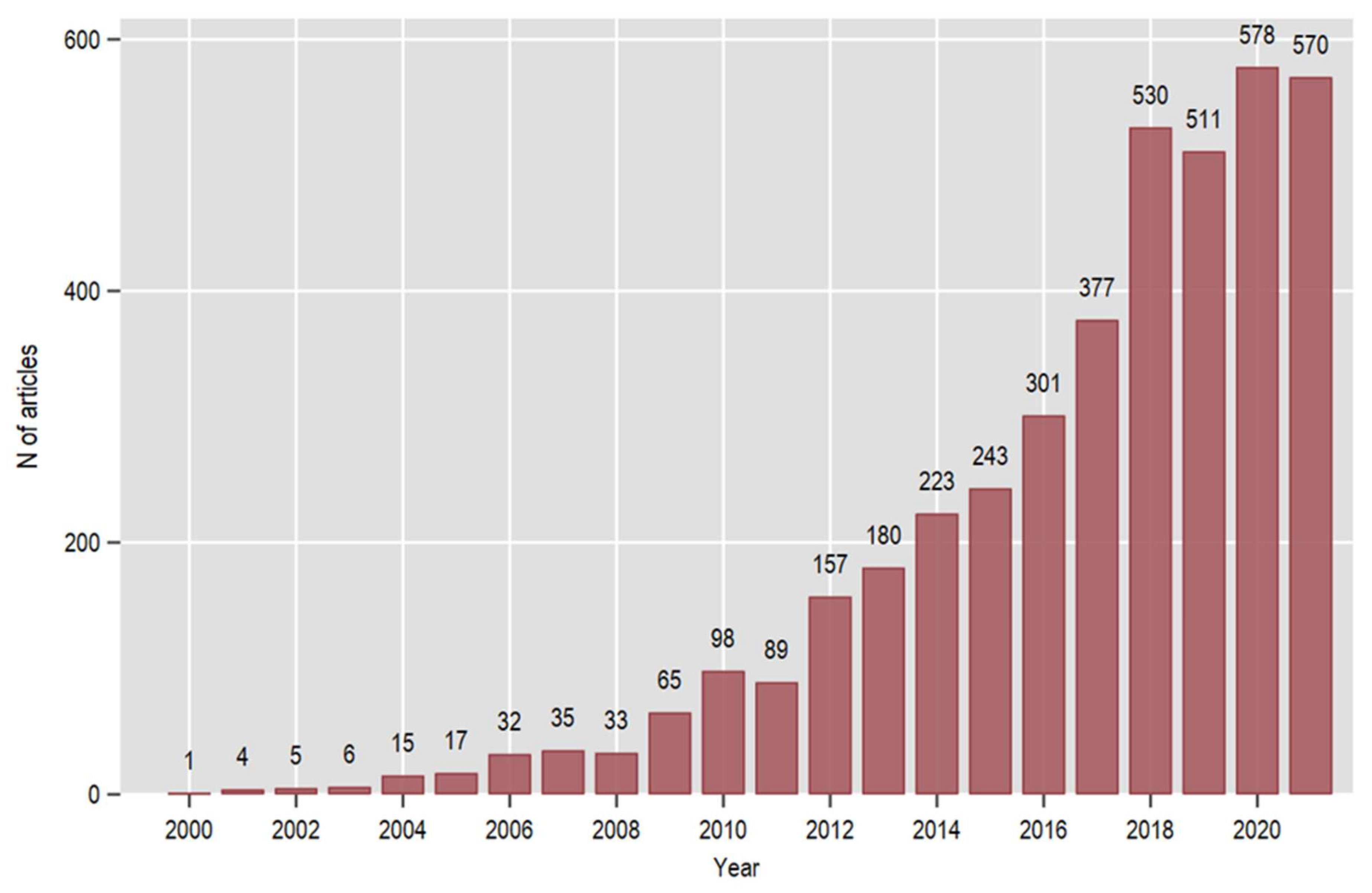
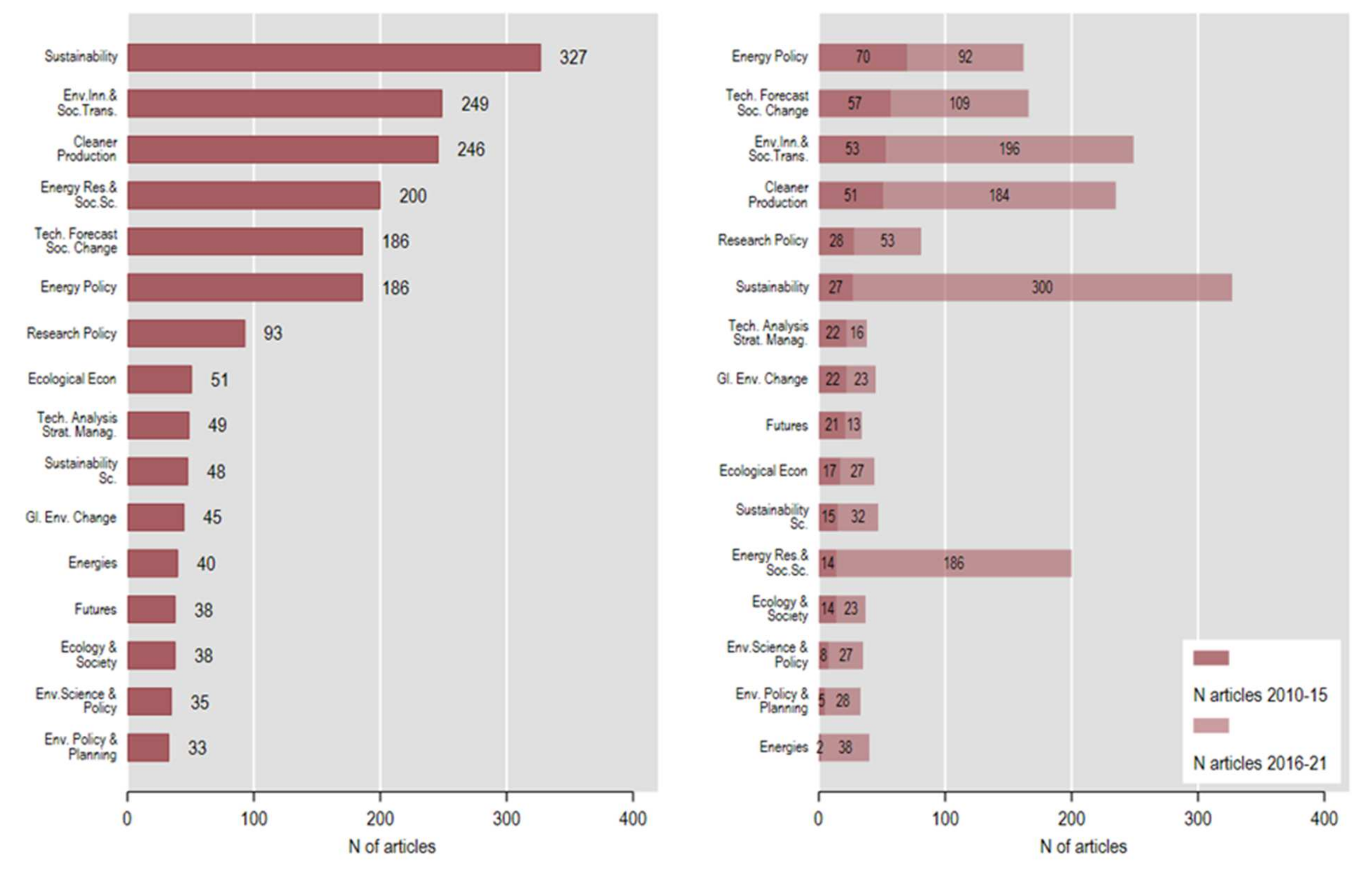
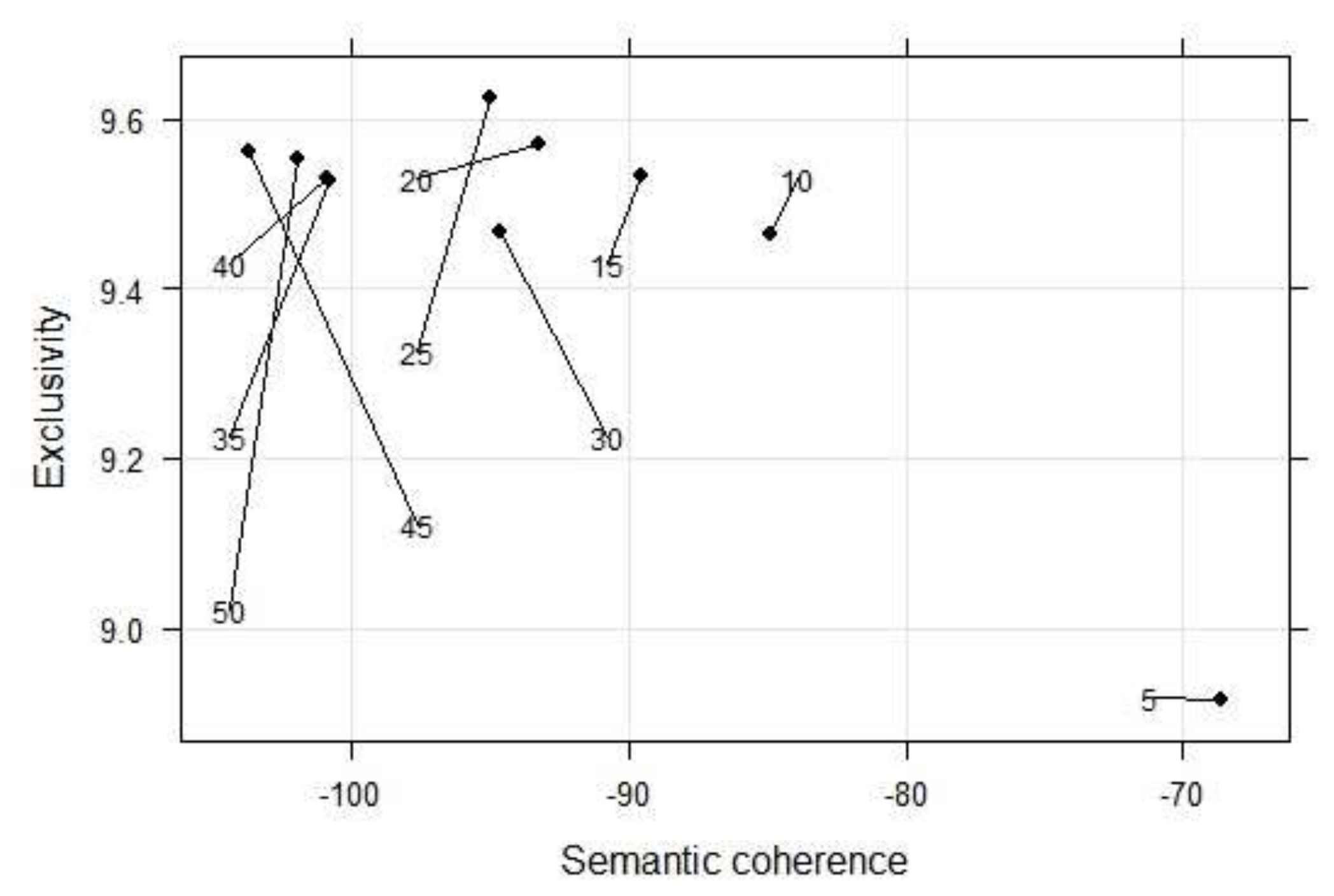
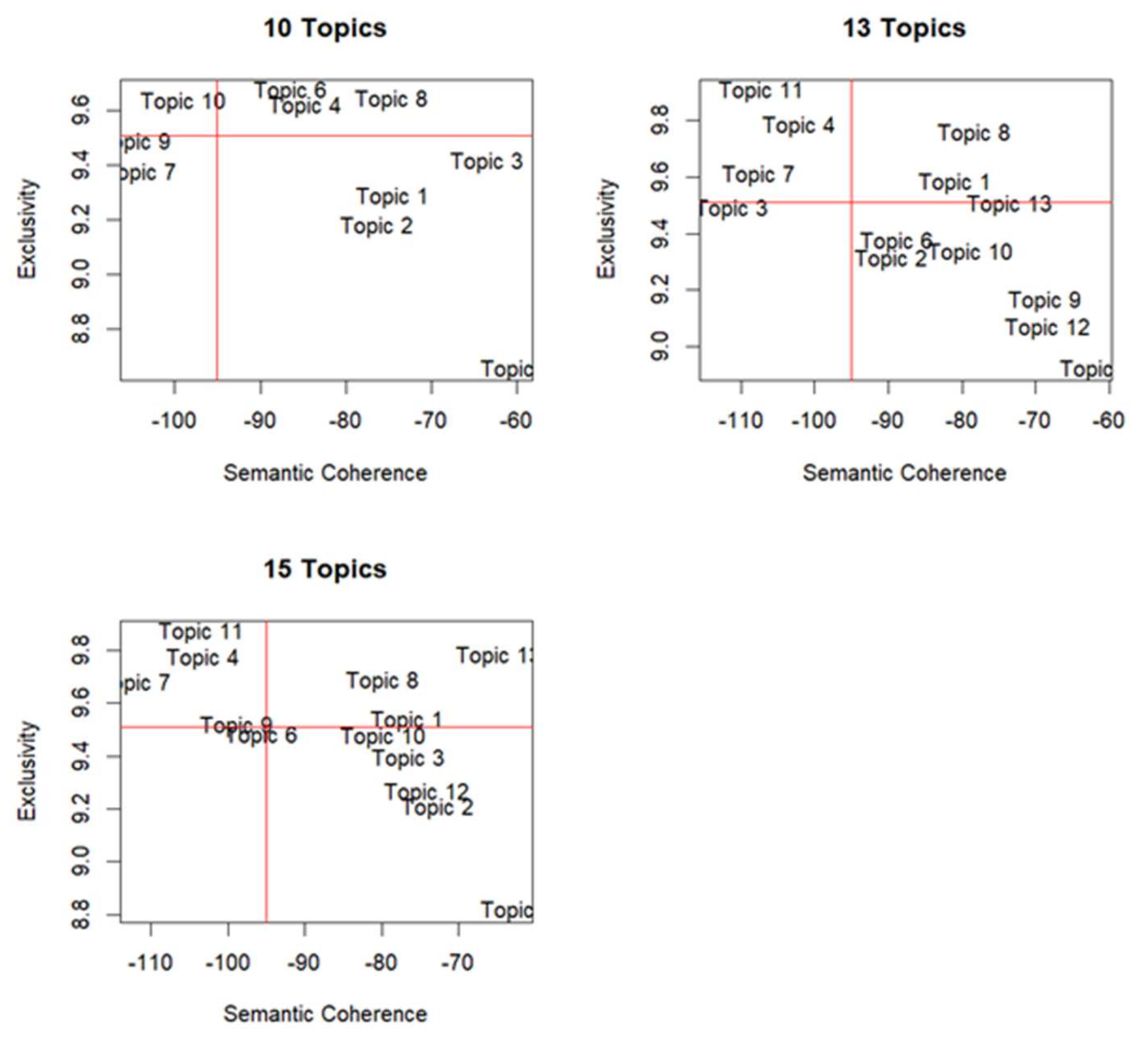
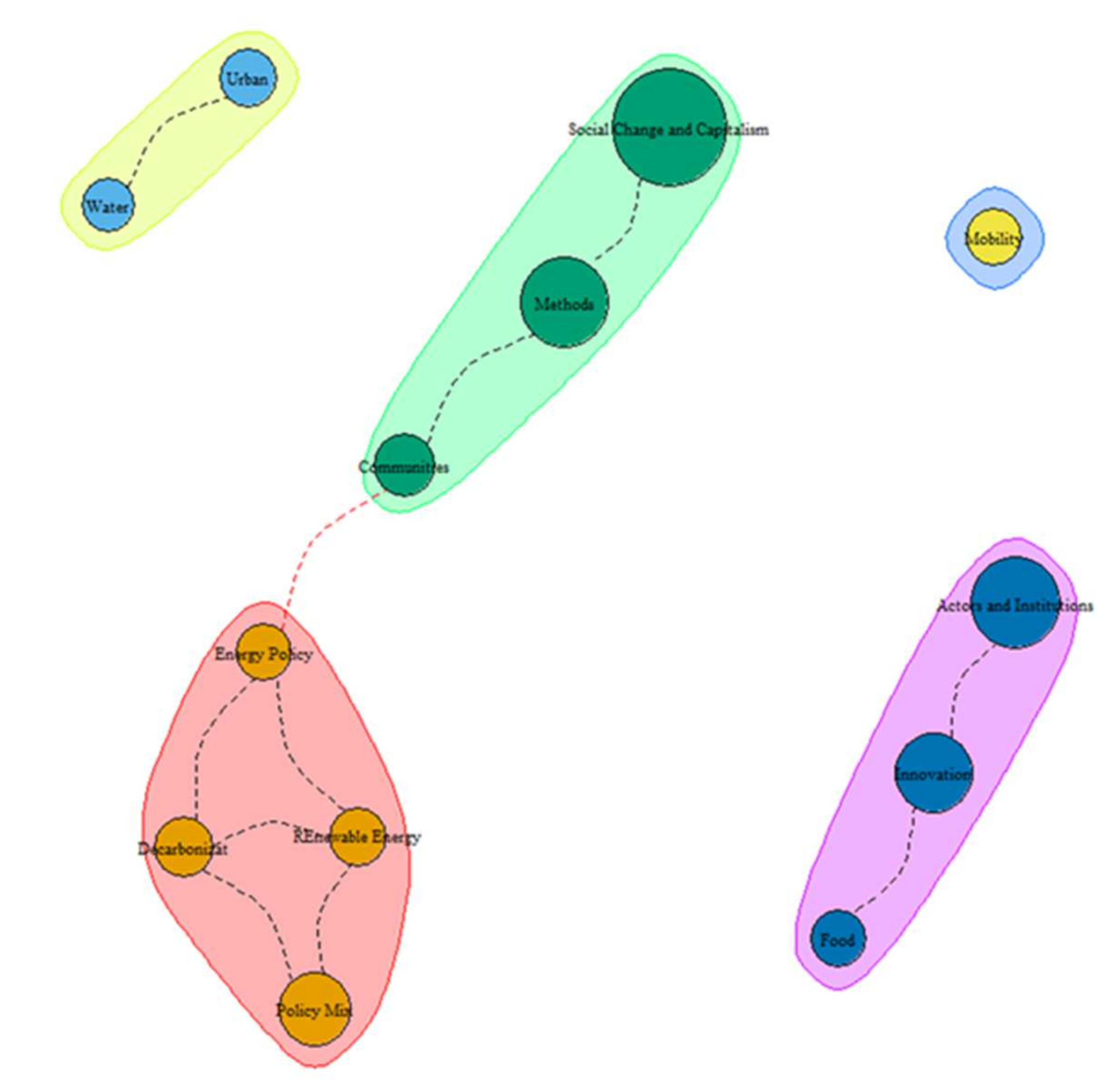
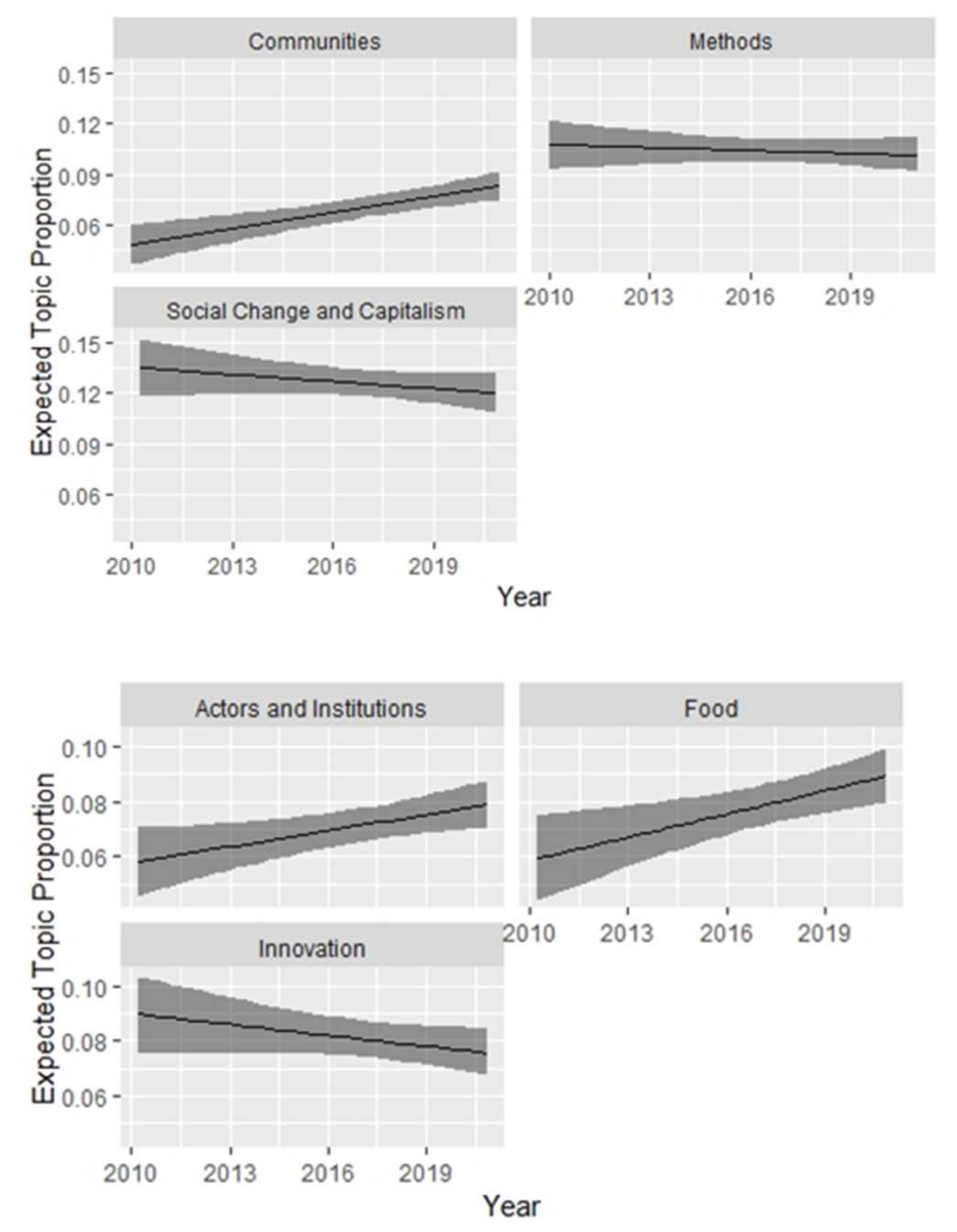
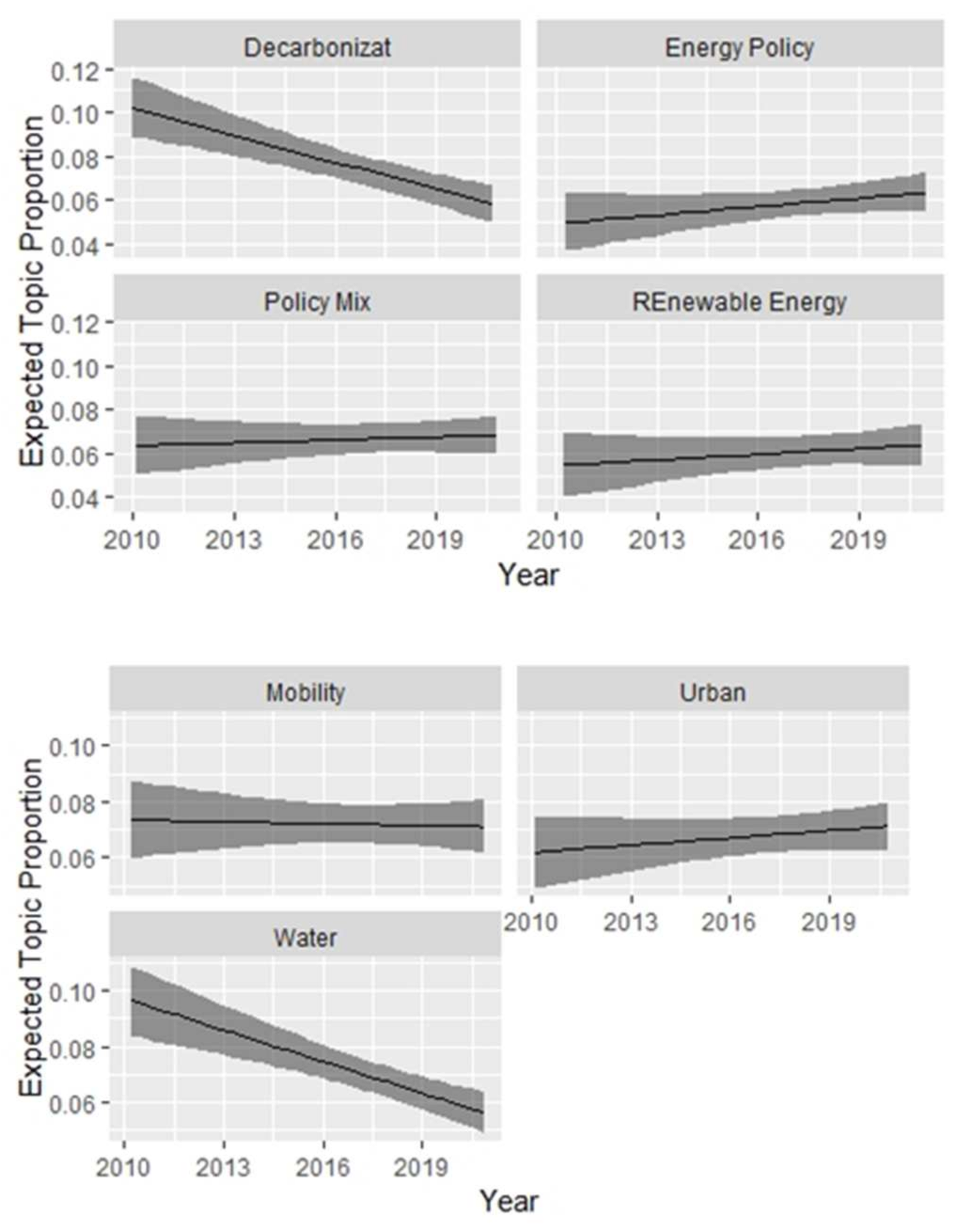
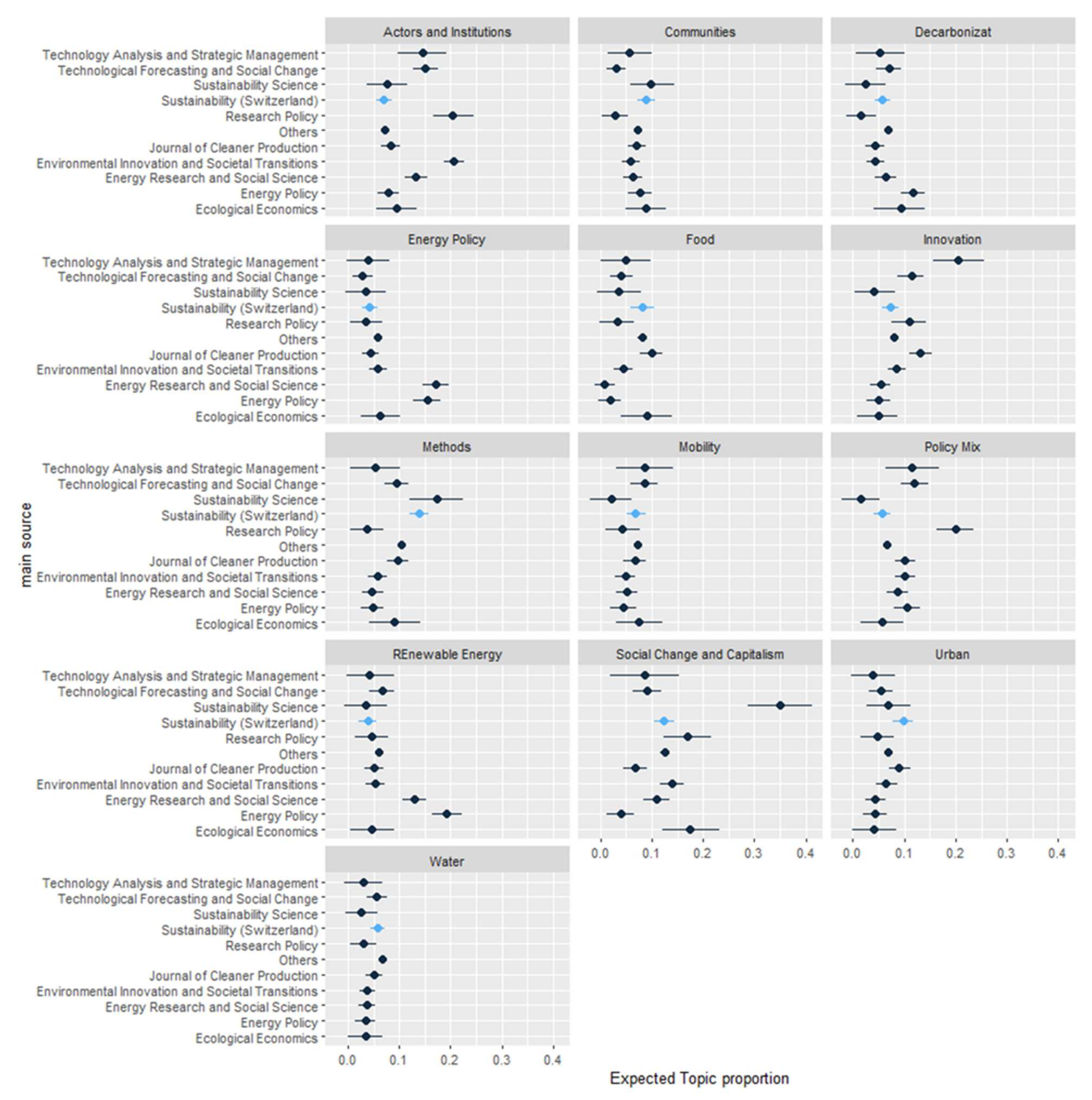
| Document Type | Observations | Percent |
|---|---|---|
| Article | 3747 | 77.42 |
| Article in Press | 1 | 0.02 |
| Book | 109 | 2.25 |
| Book Chapter | 334 | 6.90 |
| Conference Paper | 229 | 4.73 |
| Editorial | 30 | 0.62 |
| Letter | 1 | 0.02 |
| Note | 19 | 0.39 |
| Retracted | 1 | 0.02 |
| Review | 337 | 6.96 |
| Short Survey | 32 | 0.66 |
| Total | 4840 | 100.00 |
| Topic | Probability | FREX | Topic Prevalence |
|---|---|---|---|
| 1. Social Change and Capitalism | Transform, social, chang, understand, system, change, polit | Resili, reflex, transformation, transformations, social-ecolog, normat, scienc | 12.7% |
| 2. Actors and Institutions | Actor, socio-techn, institut, regim, role, case, nich | Regim, actor, multi-level, mlp, institut, intermediari, agenc | 10.0% |
| 3. Methods | Develop, use, design, system, stakehold, can, manag | Stakehold, tool, methodolog, participatori, evalu, forest, method | 9.9% |
| 4. Innovation | Innov, technolog, model, develop, busi, new, network | Busi, innovation, innov, compani, innovations, network, model | 8.6% |
| 5. Policy Mix | Polici, technolog, industri, system, innov, mix, develop | Instrument, mix, tis, polici, bioeconomi, industri, firm | 8.0% |
| 6. Communities | Local, social, initi, communiti, collect, group, individu | Communiti, grassroot, initiatives, rural, initi, communities, citizen | 6.8% |
| 7. Decarbonization | Climat, chang, carbon, emiss, technolog, develop, global | Emiss, mitig, carbon, climat, greenhous, emissions, reduct | 6.5% |
| 8. Urban | Urban, region, citi, develop, plan, experi, local | Citi, urban, experiment, region, spatial, cities, plan | 6.4% |
| 9. Renewable Energy | Electr, power, market, renew, energi, solar, wind | Wind, solar, heat, grid, coal, electr, deploy | 6.4% |
| 10. Energy Policy | Energi, renew, polit, polici, system, nation, energy | Energi, bioenergi, decentr, energy, bioga, germani, renew | 6.3% |
| 11. Food | Food, product, system, agricultur, economi, circular, use | Circular, farm, agricultur, food, agroecolog, farmer, crop | 6.2% |
| 12. Mobility | Transport, mobil, use, practic, chang, consum, consumpt | Car, mobil, user, mobility, vehicl, evs, behaviour | 6.2% |
| 13. Water | Govern, water, green, infrastructur, manag, system, chang | Water, govern, green, hous, infrastructur, australia, governance | 5.8% |
Publisher’s Note: MDPI stays neutral with regard to jurisdictional claims in published maps and institutional affiliations. |
© 2022 by the authors. Licensee MDPI, Basel, Switzerland. This article is an open access article distributed under the terms and conditions of the Creative Commons Attribution (CC BY) license (https://creativecommons.org/licenses/by/4.0/).
Share and Cite
Stefani, G.; Biggeri, M.; Ferrone, L. Sustainable Transitions Narratives: An Analysis of the Literature through Topic Modelling. Sustainability 2022, 14, 2085. https://doi.org/10.3390/su14042085
Stefani G, Biggeri M, Ferrone L. Sustainable Transitions Narratives: An Analysis of the Literature through Topic Modelling. Sustainability. 2022; 14(4):2085. https://doi.org/10.3390/su14042085
Chicago/Turabian StyleStefani, Gianluca, Mario Biggeri, and Lucia Ferrone. 2022. "Sustainable Transitions Narratives: An Analysis of the Literature through Topic Modelling" Sustainability 14, no. 4: 2085. https://doi.org/10.3390/su14042085
APA StyleStefani, G., Biggeri, M., & Ferrone, L. (2022). Sustainable Transitions Narratives: An Analysis of the Literature through Topic Modelling. Sustainability, 14(4), 2085. https://doi.org/10.3390/su14042085






